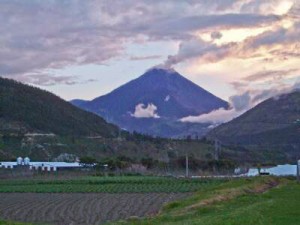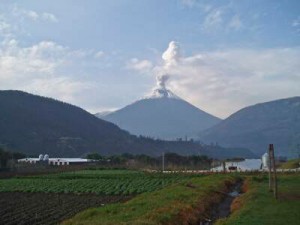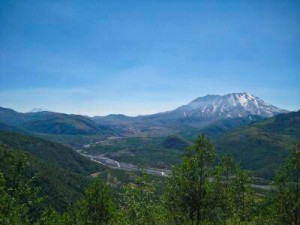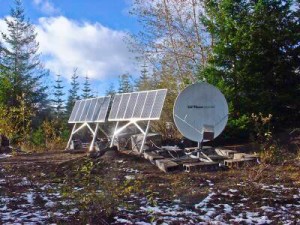8 April 2009
Low-frequency noise from erupting volcanoes resembles the roar of jet engines, a new study finds. The similarity between volcanic sounds too low for people to hear and the audible rumble made by turbulent air in a jet’s propulsion system suggests there are deeper characteristics in common between the two thunderous systems, the scientists say.
The study’s findings may make an existing sound-based probe of the inner workings of volcanic eruptions more useful than it currently is, the researchers add. The new insights might also help improve volcano hazard mitigation by forecasting which eruptions are loaded with ash.
To investigate the volcanic sounds, the researchers speeded up infrasonic sound — a sound that is lower in frequency than 20 cycles per second, below the limit of human hearing —recorded from Mount St. Helens in Washington State and Tungurahua volcano in Ecuador, both of which are highly active volcanoes close to large population centers.
“We hypothesized that these very large natural volcanic jets were making very low frequency jet noise,” says Robin Matoza, a graduate student at Scripps Institution of Oceanography in La Jolla, Calif. and leader of the study.
Matoza and his international team recorded these very large-amplitude infrasonic signals during the times when ash-laden gas was being ejected from the volcano. Using 100-meter aperture arrays of microbarometers — similar to weather barometers but sensitive to smaller changes in atmospheric pressure — and low-frequency infrasonic microphones, the scientists revealed the physics of how the large-amplitude signals from eruptions are produced. They concluded that these large-scale volcanic jets are producing sound in a similar way to the turbulent processes found in smaller-scale man-made jets.
The team’s results will be published on 18 April in the journal Geophysical Research Letters, a publication of the American Geophysical Union (AGU).
“We can draw on this area of research … to determine which eruptions are likely ash-free, and therefore less of a threat, and which are loaded with ash,” says Michael Hedlin, director of Scripps’ Atmospheric Acoustics Lab and a co-author on the paper. Volcanoes that shoot ash clouds into the atmosphere pose a serious danger to the engines of the planes flying above.
Large-amplitude infrasonic signals from volcanic eruptions are currently used in a prototype real-time warning system that informs the Volcanic Ash Advisory Center (VAAC) when large infrasonic signals have come from erupting volcanoes. Researchers hope the new findings can improve hazard mitigation and inform pilots and the aviation industry.
“Eventually it could be possible to provide [to VAAC] detailed information, such as the size or flow rate of the volcanic jet, to put into ash-dispersal forecasting models,” Matoza says.
The study was funded by a National Science Foundation grant.
American Geophysical Union Scripps Institution of Oceanography Joint Release
AGU Contact:
Maria-José Viñas, Phone: +1 (202) 777-7530, E-mail: [email protected]
Peter Weiss, Phone: +1 (202) 777-7507, E-mail: [email protected]
Scripps Contacts:
Annie Reisewitz or Rob Monroe, Phone: +1 (858) 534-3624, E-mail: [email protected]
As of the date of this press release, this study by Matoza and collaborators is still “in press” (i.e. not yet published). Journalists and public information officers (PIOs) of educational and scientific institutions who have registered with AGU can download a PDF copy of a manuscript of this paper.
Or, you may order a copy of the paper in press by emailing your request to Maria-José Viñas at [email protected] or to Annie Reisewitz of Scripps at [email protected]. Please provide your name, the name of your publication, and your phone number.
(Beginning Saturday, 18 April, registered news media and PIOs may directly download the final, copy-edited and formatted PDF of the paper.
Please see instructions for downloading.
Neither the paper nor this press release are under embargo.
Images:
Scripps Institution of Oceanography, UC San Diego
Scripps researchers are using infrasound to study Mount St. Helens volcano in Washington state
D. Fee/University of Hawaii


Scripps researchers are using infrasound recordings to study the Tungurahua volcano in Ecuador.
Note to broadcast and cable producers:
UC San Diego provides an on-campus satellite uplink facility for live or pre-recorded television interviews. Please phone or e-mail the media contact listed above to arrange an interview.
“Infrasonic jet noise from volcanic eruptions”
Robin S. Matoza and Michael A. H. Hedlin: Laboratory for Atmospheric Acoustics, Institute of Geophysics and Planetary Physics, Scripps Institution of Oceanography, La Jolla, California, USA
David Fee and Milton A. Garcés: Infrasound Laboratory, University of Hawaii, Manoa, Hawaii, USA
John M. Seiner: National Center for Physical Acoustics, University of Mississippi, Mississippi, USA
Patricio A. Ramón: Instituto Geofísico, Escuela Politécnica Nacional, Quito, Ecuador.
Robin Matoza, +1 (858) 246-0990,[email protected]


